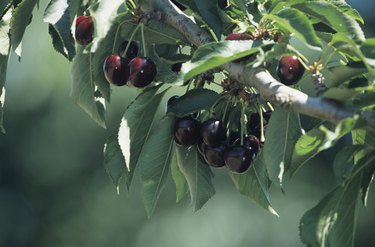
Conventional wisdom used to dictate that if you only had room for one cherry tree in your yard, it had to be a sour cherry. For centuries, only sour (pie) cherries were self-pollinating. However, you can now choose from sour, sweet or duke (a hybrid of the two) cherry trees even if you don't have room for another pollinator. Make sure to choose a self-fertile type; many sweet cherry trees still require another cherry tree in order to produce fruit.
Sour Cherries
Video of the Day
All pie cherries, also known as sour, acid or culinary cherries, are self-pollinating. Growers offer them on standard and dwarfing root stocks, and varieties include white, red or pink-fleshed fruit. Because sour cherries bloom later than sweet ones, they can't act as pollinators for self-infertile sweet cherries. These fruit trees tolerate cold weather better than sweet cherries, although sweet cherries thrive better in sticky, hot summers. Morello represents the classic and earliest sour cherry, with its almost black skin and medium-sized fruit, but it is plagued by black spot. Hardier cultivars include Montmorency, the most widely-grown sour cherry tree in the United States. Montmorency trees bear a medium-red, large cherry. North Star trees produce small fruit and boast a reputation for surviving cold winters.
Video of the Day
Sweet Cherries
For gardeners in the 1970s, Stella represented a revolutionary breakthrough. The first-ever self-fertile cherry tree, Stella made it possible for people with small yards to grow a single cherry tree whose fruit could be enjoyed fresh. Stella cherries are dark and medium-sized, and considered high-quality by connoisseurs. Early-blooming, self-fertile sweet cherries include Sandra Rose, which bears large, dark, semi-firm fruit and Santina, a black cherry type. Mid-season cherries that are self-fruiting include the vigorous Sonata, with black and sweet cherries and the classic Stella. Late-blooming, self-fertile cherry trees include Lapins, which bear large cherries that are firm and dark red; Skeena, known for its large, black and intensely sweet fruit; and dark-red Staccato, with its large, sweet cherries.
Duke Cherries
Duke cherries were bred as a cross between sour and sweet cherries. Once considered the best of both worlds, Duke cherry trees' popularity is waning, according to the Purdue University Cooperative Extension Service. Purdue horticulturalists believes that the advent of more self-pollinating sweet cherries, which come on hardier rootstock, make Duke varieties redundant. Nonetheless, nurseries like Raintree Nursery still offer Duke cherry trees. Duke cherries produce good pie cherries and, under favorable climate conditions, will sweeten enough to be eaten fresh. Self-fertile varieties include the first and most famous, May Duke.